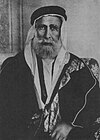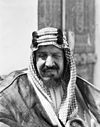Kingdom of Hejaz
| المملكة الحجازية الهاشمية | |||||
|
al-Mamlaka al-Hijāziya al-Hāschimiya |
|||||
| Hashemite Kingdom of Hejaz | |||||
| 1916-1932 | |||||
|
|||||
| Official language | Arabic | ||||
| Capital | Mecca | ||||
| Seat of government | 1924–1926 Jeddah (de facto) | ||||
| Form of government | kingdom | ||||
| Government system | 1916–1924 absolute monarchy 1924–1925 constitutional monarchy 1925–1926 provisional government 1926–1932 consultative monarchy |
||||
| Head of state | King of the Arabs until 1924 , then King of the Hejaz | ||||
| Head of government |
Prime Minister 1916 -? Ali bin Hussein ? - 1924 Ibrahim Hakki 1924–1925 Abdullah Sarraj 1925–1926 Abdullah Ali Reza 1926–1932 Faisal bin Abd al-Aziz |
||||
| surface | approx. 472,000 km² | ||||
| population | approx. 900,000 | ||||
| Population density | 2 inhabitants per km² | ||||
| currency | 1 Hejaz rial = 20 girsch, de facto also Ottoman lira , Egyptian pound , Maria Theresa thaler | ||||
| founding | October 28, 1916 | ||||
| resolution | September 23, 1932 | ||||
| National anthem | no hymn | ||||
| Time zone | UTC + 3 | ||||
| License Plate | not known | ||||
| Kingdom of Hejaz dark green, today's administrative boundaries red | |||||
The Hashemite Kingdom of Hejaz ( Arabic المملكة الحجازية الهاشمية al-Mamlaka al-Hijāziya al-Hāschimiya ), until 1924 in its own name Kingdom of Arabia , was a state in the Hejaz region that existed from 1916 to 1932. It originated in the course of the Arab revolt and was ruled by the Hashimite dynasty until 1925. After the conquest by the Saudis , the kingdom waslinkedin a personal unionwith the Sultanate (from 1927 kingdom ) Najd from 1926. In 1932 both kingdoms were formallyunited toform the Arab-Saudi Kingdom .
designation
At the initiative and insistence of his son Abdallah , Hussein declared himself King of the Arabs on October 28, 1916 . A few weeks earlier, Abdallah negotiated with Ronald Storrs about the future title of Hussein - but without result. Abdallah assured, however, not to take action in this regard without prior agreement. The proclamation came as a surprise to the British. They particularly disliked the title's claim to be ruler over all Arabs - especially since the British were allied with the Idrisids in Asir and the Saudis in Najd to support the war against the Ottoman Empire . The French also expressed concern as this claimed their colonies in North Africa. The title has been recognized internationally by Russia, Serbia and Italy. On January 1, 1917, Great Britain and France made a declaration to recognize Hussein only as King of the Hejaz . In the Treaty of Sèvres , Hussein's domain was recognized by the signatory states as the Kingdom of Hejaz . The treaty was not signed by the kingdom itself.
Hussein insisted on the title of King of the Arabs and the territorial claims that it implied, thereby alienating himself from Great Britain. Without fear of British intervention, the Saudis began the invasion of the Hejaz in 1924. Due to the bad outcome of the war, nationalists forced Hussein to abdicate in favor of his son Ali . To put themselves in a better position to negotiate with the Saudis, the nationalists merely granted Ali the title of King of the Hejaz . However, the Saudis did not want to accept a Hashimite king, so Ali had to abdicate too. On January 8, 1926, the Saudi Abd al-Aziz ibn Saud was crowned King of the Hejaz .
Flags
The flags of the Kingdom of Hejaz go back to a proposal by Mark Sykes , who designed a flag for a future all-Arab state during the preparations for the Arab revolt. The colors black, white and green stood for the three Arab caliphate dynasties of the Fatimids (green), Umayyads (white) and Abbassids (black). Red was added as the color of the Sherif of Hussein to symbolize his dynasty's rule over the Arabs.
The version from 1916 to circa 1920 became known throughout the Arab world as the Arab Revolutionary Flag , and its pan-Arab colors served as a template for other Arab flags. This is probably one of the reasons why the white stripe was replaced by a gold stripe after the Saudis conquered the Hejaz in 1926. This version, which probably coincidentally resembles the flag of the Ethiopian region of Benishangul-Gumuz , was used until the union with Najd in 1932. The flag of Saudi Arabia has been in effect since then .
Kings
| Surname | Reign | dynasty | |
|---|---|---|---|

|
Hussein bin Ali (1853–1931) |
October 28, 1916 - October 3, 1924 |
Hashimites |

|
Ali bin Hussein (1879–1935) |
October 4, 1924 - December 20, 1925 |
Hashimites |
| interregnum | |||

|
Abd al-Aziz bin Saud (1880–1953) |
January 8, 1926 - September 22, 1932 |
Saud |
literature
- Randall Baker: King Husain and the Kingdom of Hejaz . Oleander Press, Cambridge 1979. ISBN 0-900891-48-3 .
- Joshua Teitelbaum: The Rise and Fall of the Hashimite Kingdom of Arabia . London 2001. ISBN 0-8147-8270-1 .
- Erich Topf : The formation of states in the Arab parts of Turkey since the World War according to their origin, importance and viability (= Hamburg University. Treatises from the field of foreign studies . Volume 31. Series A. Law and political sciences. Volume 3). Friedrichsen, de Gruyter & Co, Hamburg 1929.
Web links
Individual evidence
- ↑ a b c d Perthes Verlag (Ed.): Gothaischer Calendar. Genealogical court calendar and diplomatic yearbook 1925 . 162nd edition. Perthes, Gotha 1925, p. 643.
- ↑ a b Baker, Randall: King Husain and the Kingdom of Hejaz. Cambridge 1979. p. 208.
- ↑ a b Baker, Randall: King Husain and the Kingdom of Hejaz. Cambridge 1979. pp. 227-228.
- ^ Teitelbaum, Joshua: The Rise and Fall of the Hashimite Kingdom of Arabia. London 2001, p. 184.
- ↑ Baker, Randall: King Husain and the Kingdom of Hejaz. Cambridge 1979. p. 197.
- ↑ Kostiner, Joseph: The Making of Saudi Arabia from 1916 to 1936. From Chieftaincy to Monarchical State. P. 101.
- ↑ Ulrich Ragozat: The national anthems of the world. A lexicon of cultural history. Herder Verlag, Freiburg im Breisgau 1982, ISBN 3-451-19655-7 , p. 213.
- ^ Neil Anthony Parker, John Weeks: Registration Plates of the World 4th Edition. Europlate, Taunton 2004, ISBN 0-9502735-7-0 , p. 498.
- ^ Teitelbaum, Joshua: The Rise and Fall of the Hashimite Kingdom of Arabia. London 2001. p. 108.
- ↑ Baker, Randall: King Husain and the Kingdom of Hejaz. Cambridge 1979. p. 114.
- ↑ Baker, Randall: King Husain and the Kingdom of Hejaz. Cambridge 1979. p. 115.
- ↑ Baker, Randall: King Husain and the Kingdom of Hejaz. Cambridge 1979. p. 204 ff.
- ↑ Joshua Teitelbaum: The rise and fall of the Hashimite kingdom of Arabia. London 2001. p. 205.
- ^ David Fromkin: A Peace to End All Peace: The Fall of the Ottoman Empire and the Creation of the Modern Middle East. New York 1990. p. 315.
- ↑ Baker, Randall: King Husain and the Kingdom of Hejaz. Cambridge 1979. p. 228.
Remarks
- ↑ On September 18, 1932, a decree for the unification of the kingdoms of Hejaz and Najd was issued, which came into force on September 23, 1932. See Wohlfahrt, Eberhard: The Arabian Peninsula. Berlin 1980. p. 226.





